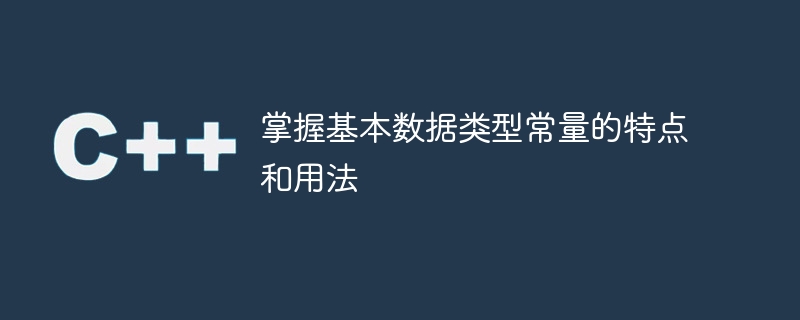

To master the characteristics and usage of basic data type constants, specific code examples are required
In programming languages, constants have fixed values. Identifiers whose values are set when they are defined and do not change during the execution of the program. For basic data type constants, mastering their characteristics and usage is the basis for writing efficient and readable code. This article will introduce the characteristics and usage of four basic data type constants, namely integer constants, floating point constants, character constants and Boolean constants. And further explained with specific code examples.
Integer constant refers to a numerical value without a decimal part, which can be a positive number, a negative number or zero. Its characteristics are as follows:
The following are some sample codes for integer constants:
int decimal = 10; // 十进制整型常量 int octal = 012; // 八进制整型常量(等价于十进制的10) int hexadecimal = 0xA; // 十六进制整型常量(等价于十进制的10) unsigned int uInt = 10u; // 无符号整型常量 long lInt = 10l; // 长整型常量 long long llInt = 10ll; // 长长整型常量
Floating point constants refer to values with decimal parts. The characteristics are as follows:
The following are some sample codes for floating-point constants:
float fNumber = 3.14f; // 单精度浮点型常量 double dNumber = 3.14; // 双精度浮点型常量 long double ldNumber = 3.14l; // 长双精度浮点型常量
Character constants refer to a single character or a constant composed of consecutive characters. The characteristics are as follows:
The following are sample codes for some character constants:
char a = 'a'; // 字符常量 char b = 65; // 使用ASCII码表示的字符常量(等价于字符'A')
Boolean constants refer to constants that represent true or false, and their characteristics are as follows:
The following is a sample code for a Boolean constant:
bool isTrue = true; // 布尔常量(真) bool isFalse = false; // 布尔常量(假)
This article introduces the functions of integer constants, floating point constants, character constants and Boolean constants Features and usage are explained with concrete code examples. Mastering the characteristics and usage of these basic data type constants is crucial to writing efficient and readable code. In the actual programming process, we should choose the appropriate constant type as needed and follow the corresponding representation rules. I hope this article can be helpful to readers in mastering basic data type constants.
The above is the detailed content of Understand the characteristics and usage of basic data type constants. For more information, please follow other related articles on the PHP Chinese website!
 direct3d function is not available
direct3d function is not available
 My computer can't open it by double-clicking it.
My computer can't open it by double-clicking it.
 Introduction to software development tools
Introduction to software development tools
 Usage of Type keyword in Go
Usage of Type keyword in Go
 Introduction to the main work content of the backend
Introduction to the main work content of the backend
 Tutorial on buying and selling Bitcoin on Huobi.com
Tutorial on buying and selling Bitcoin on Huobi.com
 How to use countif function
How to use countif function
 What currency is PROM?
What currency is PROM?




